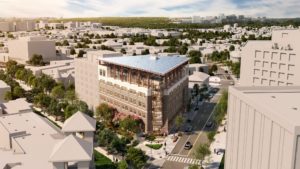
Showcase: American Geophysical Union
According to a report — Buildings and Climate Change — by the Environmental & Energy Study Institute the building industry alone is responsible for 39 percent of carbon dioxide emissions in the United States per year. High-performing green buildings play a key role in reducing the negative climate impacts of the built environment.
 The American Geophysical Union (AGU) — a not-for-profit scientific society dedicated to the advancement of Earth and space science — recognized that climate change is a real and pressing issue facing humanity with wide-ranging impacts on human and environmental health. With headquarters in Washington, D.C., for almost 40 years, the organization determined that it was time to renovate the existing office space as the building and infrastructure were reaching the end of their useful lives. They chose to renovate rather than demolish the building and re-build to reduce the environmental impact while maintaining as much of the exterior as possible — the building shell maintains the historic character of the neighborhood. With the existing 62,000 square foot building requiring a major renovation, AGU decided to take their vision to the next level. The new office space design reflects AGU’s mission of “science for the benefit of humanity,” showcasing their members’ work and values, promoting sustainable technologies and strategies that are brought together in a way that has not yet been seen before while educating the public about the positive impact science can have on society.
The American Geophysical Union (AGU) — a not-for-profit scientific society dedicated to the advancement of Earth and space science — recognized that climate change is a real and pressing issue facing humanity with wide-ranging impacts on human and environmental health. With headquarters in Washington, D.C., for almost 40 years, the organization determined that it was time to renovate the existing office space as the building and infrastructure were reaching the end of their useful lives. They chose to renovate rather than demolish the building and re-build to reduce the environmental impact while maintaining as much of the exterior as possible — the building shell maintains the historic character of the neighborhood. With the existing 62,000 square foot building requiring a major renovation, AGU decided to take their vision to the next level. The new office space design reflects AGU’s mission of “science for the benefit of humanity,” showcasing their members’ work and values, promoting sustainable technologies and strategies that are brought together in a way that has not yet been seen before while educating the public about the positive impact science can have on society.
“We want to renovate this building so that whatever we’re taking out of the environment, we can put back so that we’re operating in a sustainable ecosystem,” said AGU Chief Executive Officer Christine McEntee. “What we want our members to see is that we’ve continued the legacy that inspired this building when it was built in the early 90s… and what we are doing now builds upon that legacy, improves upon it and serves as a model for the future.”
From the start, AGU committed to sustainability and reducing the organization’s environmental footprint. Seeing the value in the latest innovative green building strategies, AGU explored the possibility of a net zero energy building — using the opportunity to transform its headquarters into a living representation of the organization’s mission, science and purpose. The headquarters renovation aimed to show what was possible in green building through a variety of sustainability strategies. In the process, the renovation has not only met but exceeded green building expectations and is a true example of what can be accomplished.
After assembling the team and developing project goals, most significantly striving for net zero, the team explored 56 options that merged into four major strategies for the project: reduction, reclamation, absorption, and generation. The process showcases the importance of studying specific conditions to meet requirements, and highlights the paradox of sustainability and rating systems, where often one beneficial aspect of design limits implementation of another.
The AGU project relied on a suite of technologies that were developed from the four major strategies guiding the project. This approach ensured that a range of options was explored, which included a trip to Europe to see first-hand how green building technologies are implemented abroad and how these technologies can be incorporated in projects in the United States.
The renovation project also provided the opportunity to lead by example as a model for sustainable design. Net zero energy means that the total amount of energy used yearly by a building is equal to or less than the amount of energy created on-site through the use of innovative technologies and renewable power generation. Net zero energy is an unprecedented sustainability goal for the urban office retrofit, typically reserved for new construction projects.
Reduction
To start, AGU looked for ways to reduce the overall initial energy demand with a high-performing building envelope; use of natural daylighting; and installed low-e, reflective glass windows that reflect heat and help keep the interior cool. Energy-efficient building control systems, improved insulation and LED lighting were installed to help reduce energy needs. A radiant cooling system will circulate chilled water through a network of pipes in the ceiling and keep the main spaces at comfortable temperatures using less energy than forced-air systems. The cooled ceiling surface panels evenly absorb heat energy transferred from people, lights and equipment. Heat and ventilation air will be provided via a dedicated outdoor air system that works in conjunction with the radiant cooling systems for ventilation, pressurization and humidity control.
The typical process of converting alternating current from the utility company to direct current to power appliances results in an energy efficiency loss of nearly 20 percent. The team opted to install a direct current electrified grid in the ceiling that will use the direct current power being generated by the solar photovoltaic array. This removes the need for the high-energy conversion process when there is adequate supply from the solar photovoltaic array. This technology allows the building to be more energy efficient, progress toward the net zero energy goal and provides the building with resiliency.
Reclamation
Reclamation strategies allow the building to reclaim energy in the building by reusing it again and again. A typical building is ventilated with air sourced from outside the building and must be heated or cooled, which accounts for about 30 percent of a building’s total energy use. An innovative hydroponic phytoremediation wall system on each floor aims to reduce energy loads and improve indoor air quality. The green wall circulates the existing indoor air through the roots of the live plants. The air is cleaned and carbon dioxide is filtered out before re-circulating in the building.
Absorption
Absorption strategies find ways for the building to absorb energy from its surroundings. When the project team discovered a large combined storm and sewer line that runs under the street just outside the AGU building they explored options for a municipal sewer heat exchange system that would bring water from the sewer line into a settling tank and then be circulated inside the building to an exchange system that extracts energy from the water for heating and cooling before the water is returned to the sewer system. The AGU building was uniquely situated to take advantage of this opportunity.
Generation
After reviewing all options for on-site renewable energy, the AGU team decided that solar photovoltaic energy was the best option for the renovation. Solar photovoltaic arrays convert solar energy into direct current electricity, and have become a standard feature in many net-zero energy projects. A solar photovoltaic array decreases the carbon footprint of a building and saves money by lowering utility bills. The AGU building’s solar photovoltaic array includes over 700 solar panels and is expected to generate enough energy to supply power for the building’s electrical needs, and even send surplus energy back to the city’s grid.
AGU will move back into the renovated office and will be working towards making their building data available online for those interested in green building performance and sustainable technologies. Tours of the space will be open to the public. Follow the AGU Project Blog to stay informed of the progress and the performance of Washington, D.C.’s first net-zero energy commercial renovation.
Click here to view the full AGU case study.







